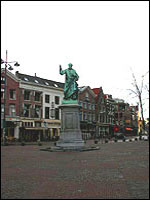| The regular practice trajectory: Haarlem-Katwijk Preface | Part I | Part II | Part III | Part IV | Part V | Back Preface  The Academic Walking Society has a regular practice trajectory, between Haarlem and Katwijk. On this trajectory we train novices, and practice regularly ourselves, working towards the, heavier, practice projects that surround the official marching season, and towards the long marches, often spanning multiple days, of that season itself. The Academic Walking Society has a regular practice trajectory, between Haarlem and Katwijk. On this trajectory we train novices, and practice regularly ourselves, working towards the, heavier, practice projects that surround the official marching season, and towards the long marches, often spanning multiple days, of that season itself.
To this effort, the practice track brings a number of great advantages. Since it is a clear, recognizable course, split into five equally recognizible phases, the marcher can, having (partially) completed it for the first time, compare his or her mental and physical state with the previous attempts quite effectively (and always better as time progresses), and accurately estimate remaining reserves. This reduces the risk of fainting because of dehydration, lack of salts, and worse. This risk is even smaller because the larger part of the route, particularly the second and therefore more strenuous part of it, is amply stocked with catering establishments, making it easy to swiftly and effectively combat shortages of food and fluids. Because this certainty exists, one can also choose to work on one's stamina in this matter. At the end of every phase, and more often as one gets further, the route touches that of public transport, ie the bus, so that the marcher can, in case of trouble, stop and leave the course without having to go through great trouble. Since the floor of the course changes from asphalt and brick to sandy beach and blocks of basalt, and because there are differences in height (that, however, are relatively minor and can therefore be engaged confidently), a complete, varied training is guaranteed. Nonetheless multiple parts are so monotonous, that this is a great preparation for the heavier practice projects and official marches, where the landscape usually varies much stronger. And yet there is enough to see: the course leads through an area rich in history, and has much to offer the lover of nature, in forests and dunes and on the beach - not to mention the numerous panoramas. To Part I | Back |